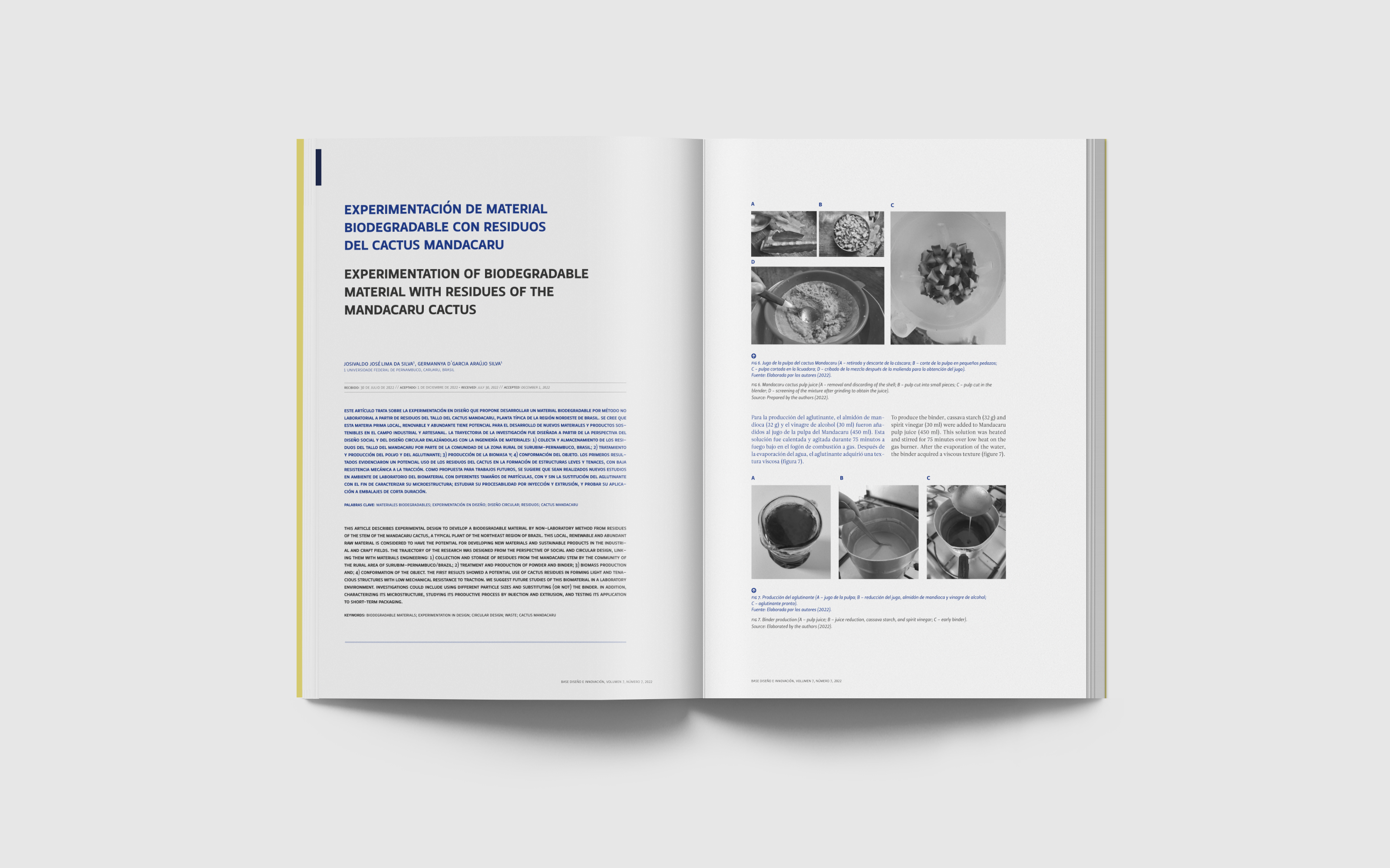Experimentation of biodegradable material with residues of the mandacaru cactus
Main Article Content
Abstract
This article describes experimental design to develop a biodegradable material by non-laboratory method from residues of the stem of the Mandacaru cactus, a typical plant of the Northeast region of Brazil. This local, renewable and abundant raw material is considered to have the potential for developing new materials and sustainable products in the industrial and craft fields. The trajectory of the research was designed from the perspective of Social and Circular Design, linking them with materials engineering: 1) Collection and storage of residues from the Mandacaru stem by the community of the rural area of Surubim-Pernambuco/Brazil; 2) Treatment and production of powder and binder; 3) Biomass Production and; 4) Conformation of the object. The first results showed a potential use of cactus residues in forming light and tenacious structures with low mechanical resistance to traction. We suggest future studies of this biomaterial in a laboratory environment. Investigations could include using different particle sizes and substituting (or not) the binder. In addition, characterizing its microstructure, studying its productive process by injection and extrusion, and testing its application to short-term packaging.
Article Details
References
Ashby, M., & Johnson, K. (2013). Materiais e design: A arte e ciência da seleção de materiais no projeto do produto. Elsevier Brasil.
Barauna, D., Renck, G. E., Santos, P. M., & Tomé, V. P. D. (2021, December 1-3). Experimentação em Design: Biomateriais como uma alternativa para a Moda Sustentável. In VIII Simpósio de Design Sustentável / Sustainable Design Symposium. https://eventos.ufpr.br/sds/sds/paper/viewFile/4500/1015
Barauna, D., Canal Marques, A., Renck, G. E., & Tomé, V. P. D. (2021, December 10). Experimentação e o cultivo de guaraná: uma aprendizagem sobre biomateriais no design. In Design & Materials 2021 IV Congresso Internacional e X Workshop. http://www.extremooriente.4users.com.br/artigo_barauna_canal_renck_tome.pdf
Barbosa, L. M., Leite, R. H., Aroucha, E. M. M., Klebson, F., & dos Santos, G. (2020). Comportamento físico-químico sob diferentes temperaturas de secagem de compósitos de fécula de mandioca e fibra de sisal. Agropecuária Científica No Semiárido, 16(2), 81-85. http://dx.doi.org/10.30969/acsa.v16i2.1229
Carvalho, M. C., & de Oliveira Santos, M. L. L. (2021, October). Estratégia para produção de revestimento em resíduo de fibra de bananeira promovendo o engajamento dos geradores da matéria-prima. In II JOP´DESIGN 2021 II Jornada de Pesquisa do Programa de Pós-Graduação em Design – UFMA. http://dx.doi.org/10.5151/jopdesign2021-18
Confederação Nacional da Indústria (2019). Pesquisa sobre Economia Circular na Indústria Brasileira. https://static.portaldaindustria.com.br/media/filer_public/a5/ab/a5abebbb-3bc9-4aed-9f2f-8914358d2f00/economia_circular__-_pesquisa_cni_2.pdf
Fibrenamics (Produtora). (2020). Design Circular de Produtos. [Video]. Portugal, DC: Fibrenamics.
Gheribi, R., & Khwaldia, K. (2019). Cactus mucilage for food packaging applications. Coatings, 9(10), 655. https://doi.org/10.3390/coatings9100655
John, M.J. and Thomas, S. (2008) Biofibres and Biocomposites. Carbohydrate Polymers, 71, 343-364. http://dx.doi.org/10.1016/j.carbpol.2007.05.040
Lee, S., Congdon, A., Parker, G., & Borst, C. (2020). Understanding ‘Bio’Material Innovations: A Primer for the Fashion Industry. Biofabricate. https://www.biofabricate.co/resources
Lopes, J. D. A. (2016). O Mandacaru e sua utilização como material expressivo e alternativo renovável no design e na arte. [Disser. Pós-Graduação em Artes Visuais]. Universidade Federal da Bahia. http://www.ppgav.eba.ufba.br/sites/ppgav.eba.ufba.br/files/dissertacao_-revisado_ort_e_normas.final_.pdf
Mainsah, H; Morrison, A. (2013). Towards a manifesto for methodological experimentation in design research. In Nordic Design Research Conference 2013, Copenhagen-Malmö. Nordes, pp. 153-167. https://archive.nordes.org/index.php/n13/article/view/287
Manzini, E. (2008). O Desenvolvimento de Produtos Sustentáveis. Editora da Universidade de São Paulo.
Mineiro, É. F. (2016). Experimentação em Design como Estratégia no Cenário da Autoprodução. [Tesis de doctorado] Pontifícia Universidade Católica do Rio de Janeiro, Departamento de Artes e Design. https://www.maxwell.vrac.puc-rio.br/29360/29360.PDF
Molena, A. C; Vidotto, A. A; Guerra, A. (2019). Produção de canudos biodegradáveis e comestíveis à base de pectina. Trabalho de Conclusão de Curso (Curso Técnico em Química – Etec Amim Jundi, Osvaldo Cruz, SP. orientadora: Rebeca Zuliani Galvão, 2019.
Nepomuceno, N. C., Santos, A. S., Oliveira, J. E., Glenn, G. M., & Medeiros, E. S. (2017). Extraction and characterization of cellulose nanowhiskers from Mandacaru (Cereus jamacaru DC.) spines. Cellulose, 24(1), 119-129. https://doi.org/10.1007/s10570-016-1109-5
Oliveira, I. C. M. D. (2019). Design Social como fator de desenvolvimento regional sustentável baseado nas competências e recursos naturais locais. https://hdl.handle.net/1822/65370
Ortiz, S. P., & Arce, M. M. (2016). Producción y Caracterización de Películas de Biopolímero de Nopal Opuntia fícus-indica (L.). Research Gate GmbH. Extraído el 15 de Julio de 2021 desde Produccion-y-Caracterizacion-de-Peliculas-de-Biopolimero-de-Nopal-Opuntia-ficus-indica-L.pdf (researchgate.net)
Papanek, V. (1985). Design for the Real World: Human Ecology and Social Change. Academy Chicago Publishers.
Peltier, F., & Saporta, H. (2009). Design sustentável: caminhos virtuosos. Editora Senac São Paulo.
Purasachit, I. (2021). The designerly approach in material development: a design-led exploration of surplus flowers as raw material. [Master of Arts Thesis] School of Arts, Design and Architecture Department of Design, Aalto University
Rosa da Silva, I. C., & Freire de Oliveira, A. K. (2021). Ecocompósito de resina vegetal e resíduos de fibra de piaçava: Estudos de usinagem e sensorialidade para aplicações no campo do design. Design E Tecnologia, 11(23), 24-37. https://doi.org/10.23972/det2021iss23pp24-37
Silva, L. F. C. R., Valle, L. D. S., Nascimento, A. R. C., & Medeiros, M. F. T. (2019). Cereus jamacaru DC. (Cactaceae): From 17 th century naturalists to modern day scientific and technological prospecting. Acta Botanica Brasilica, 33, 191-197. https://doi.org/10.1590/0102-33062018abb0352
Silva, L. M. D. Q. (2019). Avaliação do potencial de cactáceas para aplicações em processos biotecnológicos. [Bachelor Monography] Universidade Federal de Campina Grande. http://dspace.sti.ufcg.edu.br:8080/xmlui/bitstream/handle/riufcg/8369/LUANA%20MARIA%20DE%20QUEIROZ%20SILVA%20-%20TCC%20ENG.%20DE%20BIOTECNOLOGIA%20E%20BIOPROCESSOS%202019.pdf?sequence=1&isAllowed=y
Silveira, M., Menali, L., da Gloria, M., Toledo Filho, R., & Ferreira, S. (2019). Use of alternative aggregate for lightweight concrete production. Academic Journal of Civil Engineering, 37(2), 576-582. https://doi.org/10.26168/icbbm2019.84
Smol, M., Kulczycka, J., & Avdiushchenko, A. (2017). Circular economy indicators in relation to eco-innovation in European regions. Clean Technologies and Environmental Policy, 19(3), 669-678. https://doi.org/10.1007/s10098-016-1323-8
Souza, J. H. S., dos Santos Rocha, T. O., dos Santos Gomes, I., da Silva Nascimento, A., Silva, D. S., da Silva Nascimento, E., & Fujiyama, R. T. (2019). Materiais compósitos de matriz poliéster com reforço híbrido de tecido de fibras de juta e mantas de fibra de vidro. Brazilian Applied Science Review, 3(1), 777-790. https://ojs.brazilianjournals.com.br/ojs/index.php/BASR/article/view/881/763
Vieira, K. (2021). Síntese e caracterização de um compósito polimérico biodegradável utilizando poli (ácido lático) e borra de café. [Master Thesis Dissertation] Universidade Federal de Santa Catarina. https://repositorio.ufsc.br/bitstream/handle/123456789/226884/PPCM0082-D.pdf?sequence=-1


